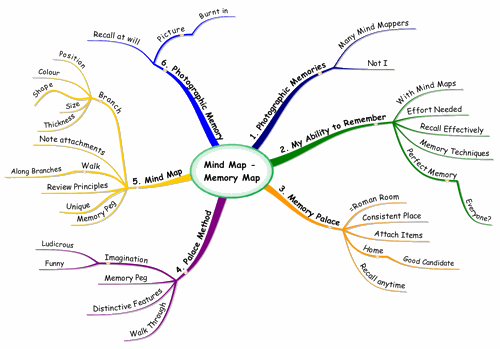Mind Map Memory Maps can awaken your perfect memory...

Using Mind Map Memory Maps to improve your memory can take your memory to the levels only achieved by geniuses until now. You may even develop a photographic memory.
Subscribe to Using Mind Maps
Get Access to the Best Mind Mapping Tips, Tools, Techniques Resources and Opinions.
Photographic memories
There are many Mind Mappers out there that claim to have developed photographic memories with Mind Map Memory Maps.
Unfortunately, I have not been so lucky. Yet, I sell the concept of how to improve your memory with Mind Maps and Mind Mapping?
Is this a contradiction? I would like to say, 'No!' Please let me explain.
My ability to remember
While I have not developed a photographic memory, I have developed the incredible ability to remember whatever I want to remember with the use of Mind Map Memory Maps.
I have to put some effort into recalling what I have worked so hard at putting into memory, but I will be able to recall the information when I need it.
In other words, I have learned memory techniques to recall at random any piece of information that I chose to put into long term memory. Many scientists believe that our memories are perfect; All we need are the correct triggers to recall what is already there.
The Memory Palace
I recently downloaded 'The very best of Litemind' from www.litemind.com, which explains the concept of the Memory Palace. It is the same concept that Tony Buzan calls 'The Roman Room' system in his book, 'Use your Head.'
It is the same system that Dominic O'Brien, eight time world memory champion, used to memorise 54 Decks of cards in sequence, viewing each card only once.
The Memory Palace Method
Basically, the method consists of fixing in your mind a consistent place to which you can attach items that you want to remember.
For example, you could put together a memory palace of your own home, which you know very well. You should plan a route through your house. Picture yourself walking along the route. Note the items that are visible on the route. Do this until you can comfortably walk along the route and remember the items at will along the route. It is better to walk along the route than to simply picture a static image of the route.
You should do this until you are able to recall this at any time you so wish.
Once this has been done, you have a memory palace to which to attach the items you want to remember.
Now walk through your memory palace and look at distinctive features of items along the route. Look at what makes the items unique and different.
After doing this, you will have an amazing Memory Map, which contains 'memory hooks' onto which you can attach the items you want to remember. This is called a memory peg. You simply take a known image and peg it to the item that you want to memorise.
Now for some practice
- Take a list that you want to remember.
- Start at the beginning of your route.
- Look at the first item on your list and attach it to an item in your memory palace.
- Use your imaginaion to make ludicrous, funny associations.
- The only rule that you need to uphold is that if it is boring, it is wrong.
Get the picture?
What has this got to do with Mind Mapping?
The Mind Map Memory Map
I use the same techniques when I Mind Map a subject. I build a unique Mind Map for the subject that I want to learn.
Mind Map Memory Maps act like memory pegs. Each branch is unique. That is why I like to use the Mind Map principles that Tony Buzan promotes. An article on the Mind Map principles can be found here.
Once your Mind Map has been drawn, you can use it as a memory palace. Walk along the branches of your Mind Map, starting at branch number one. I always draw my branches of my Mind Maps in the same order and place. I start at 'One O'clock' and work my way clockwise around the central image. You can also number your branches to fix the route more firmly in your mind.
Walk along each of the branches and as you move along the branch, note what is attached to the branch. The branches and images serve as memory pegs to which the information is attached. Note the colour, shape, size, thickness, etc. of the branch as you attach the information written on the branch to it. Also note the position of the branch on the page.
You could also add some life to the objects on the Mind Map. If you were doing the human body and you came to the heart, you could picture a giant pumping heart. Hear the heartbeat. Is it beating fastly or slowly? What colour is it?
Photographic Memory
With practice, you will be able to instantly recall entire Mind Map Memory Maps at will. This can be seen as a photographic memory. Not in the traditional sense of the term, where you look at something once and instantly recall it at any point in the future, but in the sense that once the picture is 'burnt' into your mind, you can recall it at any time you want.
Using your Mind Maps dynamically in this fashion is the secret to using Mind Map Memory Maps to improve your memory.
I hope that this adds a new dimension to your Mind Mapping experience, especially if you were seeing the Mind Map as a static, dead object. Click here to learn about our unique Learning Management Program...
Return from Mind Map Memory Maps to Using Mind Maps home page


